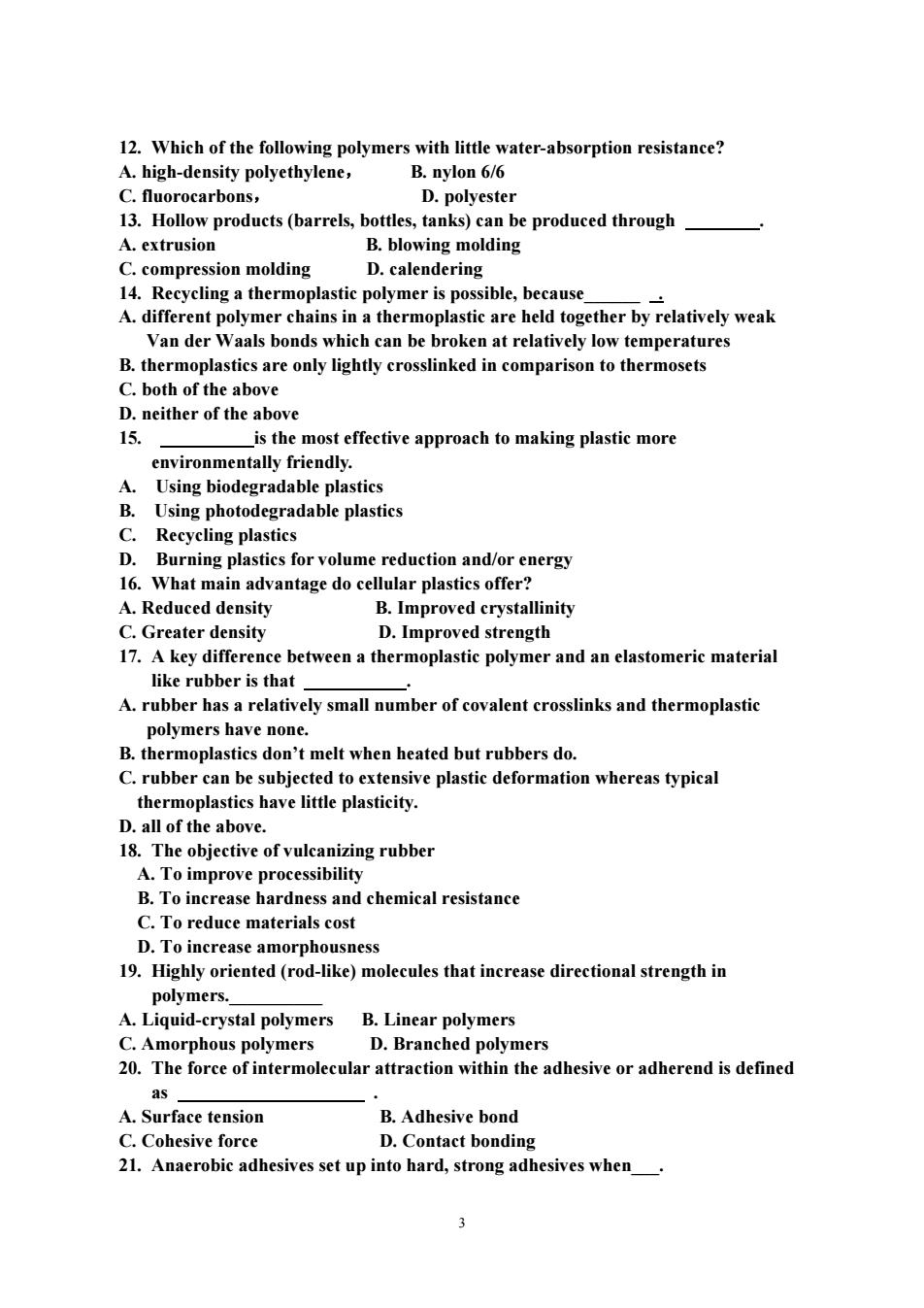正在加载图片...

12.Which of the following polymers with little water-absorption resistance? B.nylon 66 D.polyester 13.Hollow products(barrels,bottles,tanks)can be produced through A.extrusion B.blowing molding C.compression molding D.calendering 14 Re cycling a ther plastic polymer is p ssible,because A er chains in oplastic are held together by relatively weak Van der Waals bonds which can be broken at relatively low temperatures B.thermoplastics are only lightly crosslinked in comparison to thermosets C.both of the above D.neither of the above is the most effective approach to making plastic more environmentally friendly. 4. Using biodegradable plastics B.Using photodegradable plastics C.Recycling plastics ning g plastics for volume reduction and/or nergy 16.What main ady vantage do c ar plastics offer A.Reduced density B.Improved crystallinity C.Greater densitv D.Improved strength 17.A key difference between a thermoplastic polymer and an elastomeric material like rubber is that A.rubber has a relatively small number of covalent crosslinks and thermoplasti polymers have none B.thermoplastics don't melt when heated but rubbers do. C.rubber can be subjected to extensive plastic deformation whereas typical thermoplastics have little plasticity. D.all of the above 18.The objective of vulcanizing rubber A.To improve processibility B.To increase hardness and chemical resistance C.To reduce materials cost D.To increase amorphou 19.Highly oriented(rod-like)molecules that increase directional strength in polymers A.Liquid-crystal polymers B.Linear polymers C.Amorphous polymers D.Branched polymers 20.The force of intermolecular attraction within the adhesive or adherend is defined a A.Surface tension B.Adhesive bond C.Cohesive force D.Contact bonding 21.Anaerobic adhesives set up into hard,strong adhesives when. 33 12. Which of the following polymers with little water-absorption resistance? A. high-density polyethylene, B. nylon 6/6 C. fluorocarbons, D. polyester 13. Hollow products (barrels, bottles, tanks) can be produced through . A. extrusion B. blowing molding C. compression molding D. calendering 14. Recycling a thermoplastic polymer is possible, because______ . A. different polymer chains in a thermoplastic are held together by relatively weak Van der Waals bonds which can be broken at relatively low temperatures B. thermoplastics are only lightly crosslinked in comparison to thermosets C. both of the above D. neither of the above 15. is the most effective approach to making plastic more environmentally friendly. A. Using biodegradable plastics B. Using photodegradable plastics C. Recycling plastics D. Burning plastics for volume reduction and/or energy 16. What main advantage do cellular plastics offer? A. Reduced density B. Improved crystallinity C. Greater density D. Improved strength 17. A key difference between a thermoplastic polymer and an elastomeric material like rubber is that . A. rubber has a relatively small number of covalent crosslinks and thermoplastic polymers have none. B. thermoplastics don’t melt when heated but rubbers do. C. rubber can be subjected to extensive plastic deformation whereas typical thermoplastics have little plasticity. D. all of the above. 18. The objective of vulcanizing rubber A. To improve processibility B. To increase hardness and chemical resistance C. To reduce materials cost D. To increase amorphousness 19. Highly oriented (rod-like) molecules that increase directional strength in polymers.__________ A. Liquid-crystal polymers B. Linear polymers C. Amorphous polymers D. Branched polymers 20. The force of intermolecular attraction within the adhesive or adherend is defined as . A. Surface tension B. Adhesive bond C. Cohesive force D. Contact bonding 21. Anaerobic adhesives set up into hard, strong adhesives when___